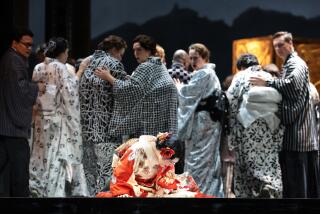Spirits Take Wing at Butterfly Aviary
- Share via
BRANSON, Mo. — At first, the room appears to be full of flittering flowers, their vibrant-colored petals floating through the air, sometimes landing on the shoulder of an awe-struck visitor before lifting up once again.
A closer look reveals the flowers are not flowers, but 1,500 butterflies of every color and type dancing to soft music in a specially designed playground just for them.
Tucked in the hills outside Branson, the Butterfly Place is a giant aviary where tigers, monarchs, painted ladies, zebra longwings and other varieties play among a winding swath of milkweed and heather.
“If the butterflies could talk I think they would say they are happy here,” says owner Bill Hill, who opened the attraction a year ago to give tourists an alternative to Branson’s fiddles and performers.
The 9,000-square-foot habitat is among a growing number of live exhibits, or “butterfly zoos,” including about 20 in North America. Visitors can sit on benches and take in the scene, snap close-up pictures of exotic varieties and learn something about the life cycle of one of nature’s most mysterious creatures.
“Butterflies don’t bite, they don’t sting and you can walk among them without any threat,” said Nancy Greig, director of the Butterfly Center at the Houston Museum of Natural Sciences. “Plus, butterflies are cool insects. It might be harder to sell something like a cockroach exhibit.”
The butterflies at Hill’s aviary arrive from farms in Florida, Africa, Costa Rica and the Philippines as chrysalises--the cocoon stage between larva and adult--and are put on display for visitors to observe.
Most live only about two weeks after hatching from the cocoon, but a steady supply of new ones ensures a fresh exhibit worth coming back for.
One recent afternoon, butterfly attendant Barbara Shaffer released several white and black striped zebras from Costa Rica to a chorus of “oohs” and “aahs” from a small crowd gathered around her.
“Their wings are actually made up of microscopic scales. If these scales are altered, they might have trouble flying. If they can’t fly, they can’t eat,” Shaffer explains to a small girl, cautioning her not to touch the alluring insects.
Live butterfly exhibits were popularized in England in the 1970s, appealing to Europeans’ love for greenhouses and natural settings. The first one in the United States--built in Coconut Creek, Fla., in 1988--was a bit more of a risk.
“We knew the English were into wildlife and plants, but here everything is Disney and animation. We weren’t sure how people would respond,” said Ron Boender, founder of Butterfly World in Coconut Creek.
But after stories in the New York Times and on “Good Morning America,” Butterfly World took off. Now, hundreds of thousands of tourists visit the exhibit yearly, and 5,000 butterflies take wing every day.
“It’s breathtaking. We keep so many flying that it’s like rain,” Boender said. “People are looking for alternatives to boring old museums without losing the educational value, and we give it to them.”
Part of the exhibit at the Butterfly Place teaches the precious life cycle of the butterfly: A tiny egg is attached to a leaf or branch. From this a hungry caterpillar emerges and immediately begins eating greens and shedding skin. Next is the pupa stage, or cocoon, when the caterpillar is liquefied and reshaped. Finally, the butterfly emerges from the cocoon with damp and colorful wings.
It’s a transformation Hill understands well.
A native of Chicago with a background in marketing, he left the city in 1979 looking for a life change himself. He opened a restaurant in Naples, Fla., but still wasn’t satisfied.
Contemplating his move, Hill wandered into Butterfly World in Florida one day and was blown away. That’s when a Blue Morpho landed on his shoulder and changed his life forever.
“They say it’s lucky when a butterfly lands on you,” Hill says. “This one was inspiring and lucky.”
For the last 10 years he has operated Butterflies in Flight, a butterfly breeding farm in Naples. On tropical plants in year-round warmth, butterflies lay their eggs and complete their life cycles.
Hill raises about 2,000 a week; he distributes them to his two live aviaries--one in Branson and the other in Westford, Mass., near Boston--and sells the rest to zoos, botanical gardens and other places. He’s also doing a growing business in butterflies released at weddings and funerals.
As for his other suppliers, Hill said, he is careful about who he buys from. His supplier in Costa Rica is a former Peace Corps worker who now trains local people to raise butterflies and produce a fair income without destroying the rain forest.
And his supplier in Kenya has helped the community raise money for a new school, textbooks and a teacher.
“It matters to me where my supply is coming from and who is benefiting,” Hill says.
There are about 20,000 species of butterflies in the world, and about 725 species have been identified in North America, north of Mexico.
Groups like the North American Butterfly Assn., although vocal in their opposition to seeing butterflies released at weddings and public events, say live exhibits are usually harmless.
“It’s no different than a zoo. Some people don’t like to see animals in the zoo; others appreciate it,” said association president Jeffrey Glassberg. “We have no problems with live exhibits. In fact, if it helps expand the number of people interested in these glorious insects, all the better.”
*
On the Net:
https://www.butterflyplace.com
More to Read
Sign up for The Wild
We’ll help you find the best places to hike, bike and run, as well as the perfect silent spots for meditation and yoga.
You may occasionally receive promotional content from the Los Angeles Times.






